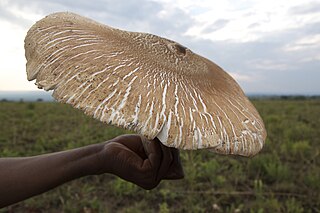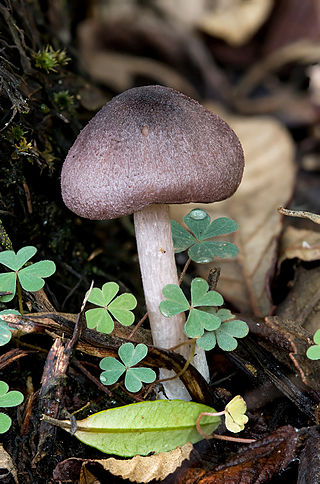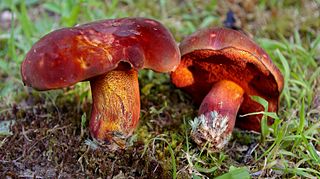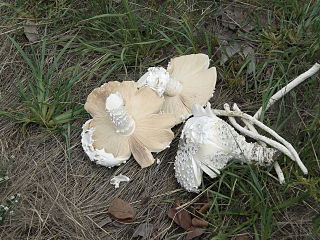
Termitomyces, the termite mushrooms, is a genus of basidiomycete fungi belonging to the family Lyophyllaceae. All of which are completely dependent on fungus-growing termites, the Macrotermitinae, to survive, and vice versa. They are the food source for these termites, who enjoy an obligate symbiosis with the genus similar to that between Atta ants and Attamyces mushrooms. Termitomyces mushrooms are edible, and are highly regarded for their flavor.

The Macrotermitinae, the fungus-growing termites, constitute a subfamily of the family Termitidae that is only found within the Old World tropics.

Termitomyces titanicus is a species of fungus in the Lyophyllaceae family. Found in West Africa, it has a cap that may reach 1 metre (3 ft) in diameter on a stipe up to 22 inches (57 cm) in length. Termitomyces is symbiotic with termites of the genus Macrotermes who raise the hyphae upon partially digested leaves as their primary foodstuff. T. titanicus was unknown to Western science prior to 1980, even though it was a common item in the native markets. Pegler and Piearce made no attempt to explain its late discovery.

Xerocomellus zelleri, commonly known as Zeller's bolete, is an edible species of mushroom in the family Boletaceae. First described scientifically by American mycologist William Alphonso Murrill in 1912, the species has been juggled by various authors to several genera, including Boletus, Boletellus, and Xerocomus. Found solely in western North America from British Columbia south to Mexico, the fruit bodies are distinguished by their dark reddish brown to nearly black caps with uneven surfaces, the yellow pores on the underside of the caps, and the red-streaked yellow stems. The fungus grows in summer and autumn on the ground, often in Douglas fir forests or on their margins. The development of the fruit bodies is gymnocarpic, meaning that the hymenium appears and develops to maturity in an exposed state, not enclosed by any protective membrane.

Cantharellus lateritius, commonly known as the smooth chanterelle, is a species of edible fungus in the mushroom family Cantharellaceae. An ectomycorrhizal species, it is found in Asia, Africa, and North America. The species has a complex taxonomic history, and has undergone several name changes since its first description by American mycologist Lewis David de Schweinitz in 1822. The fruit bodies of the fungus are brightly colored yellow to orange, and usually highly conspicuous against the soil in which they are found. At maturity, the mushroom resembles a filled funnel with the spore-bearing surface along the sloping outer sides. The texture of the fertile undersurface (hymenium) of the caps is a distinguishing characteristic of the species: unlike the well-known golden chanterelle, the hymenium of C. lateritius is much smoother. Chemical analysis has revealed the presence of several carotenoid compounds in the fruit bodies.

Entoloma austroprunicolor is a species of agaric fungus in the family Entolomataceae. Described as new to science in 2007, it is found in Tasmania, where it fruits on the ground of wet sclerophyll forests in late spring to early winter. The fruit bodies (mushrooms) have reddish-purple caps measuring up to 5 cm (2.0 in) in diameter supported by whitish stipes measuring 3–7.5 cm (1.2–3.0 in) long by 0.2–0.6 cm (0.1–0.2 in) thick. On the cap underside, the crowded gills are initially white before turning pink as the spores mature.

Mycena overholtsii, commonly known as the snowbank fairy helmet or fuzzy foot, is a species of fungus in the family Mycenaceae. The mushrooms produced by the fungus are relatively large for the genus Mycena, with convex grayish caps up to 5 cm (2 in) in diameter and stems up to 15 cm (6 in) long. The gills on the underside of the cap are whitish to pale gray, and initially closely spaced before becoming well-spaced at maturity after the cap enlarges. The mushrooms are characterized by the dense covering of white "hairs" on the base of the stem. M. overholtsii is an example of a snowbank fungus, growing on well-decayed conifer logs near snowbanks, during or just after snowmelt. Formerly known only from high-elevation areas of western North America, particularly the Rocky Mountain and Cascade regions, it was reported for the first time in Japan in 2010. The edibility of the mushroom is unknown. M. overholtsii can be distinguished from other comparable species by differences in location, or spore size.

Psilocybe aztecorum is a species of psilocybin mushroom in the family Hymenogastraceae. Known from Arizona, Colorado, central Mexico, India and Costa Rica, the fungus grows on decomposing woody debris and is found in mountainous areas at elevations of 2,000 to 4,000 m, typically in meadows or open, grassy conifer forests. The mushrooms have convex to bell-shaped caps 1.5–2 cm (0.6–0.8 in) in diameter, atop slender cylindrical stems that are up to 7.5 cm (3.0 in) long. The color of the caps changes with variations in hydration, ranging from dark chestnut brown to straw yellow or whitish when dry. The base of the stem is densely covered with conspicuous white rhizomorphs, a characteristic uncommon amongst Psilocybe species.
Strobilomyces foveatus is a little-known species of fungus in the family Boletaceae. It was first reported by mycologist E.J.H. Corner in 1972, from specimens he collected in Malaysia in 1959, and has since been found in Australia. Fruit bodies are characterized by the small dark brown to black conical scales covering the cap, and the net-like pattern of ridges on the upper stem. The roughly spherical spores measure about eight micrometres, and are densely covered with slender conical spines. The edibility of this species is unknown.

Suillus pungens, commonly known as the pungent slippery jack or the pungent suillus, is a species of fungus in the genus Suillus. The fruit bodies of the fungus have slimy convex caps up to 14 cm (5.5 in) wide. The mushroom is characterized by the very distinct color changes that occur in the cap throughout development. Typically, the young cap is whitish, later becoming grayish-olive to reddish-brown or a mottled combination of these colors. The mushroom has a dotted stem (stipe) up to 7 cm (2.8 in) long, and 2 cm (0.8 in) thick. On the underside on the cap is the spore-bearing tissue consisting of minute vertically arranged tubes that appear as a surface of angular, yellowish pores. The presence of milky droplets on the pore surface of young individuals, especially in humid environments, is a characteristic feature of this species. S. pungens can usually be distinguished from other similar Suillus species by differences in distribution, odor and taste. The mushroom is considered edible, but not highly regarded.

Mycena intersecta is a species of mushroom in the family Mycenaceae. First reported as a new species in 2007, it is known only from central Honshu, in Japan, where it is found growing solitarily or scattered, on dead leaves in lowland forests dominated by oak. The mushrooms have olive-brown caps up to 12 mm (0.47 in) in diameter atop slender stems that are 50 to 80 mm long by 0.7 to 1.2 mm thick. On the underside of the cap are the distantly spaced, whitish gills that have cross-veins running between them. Microscopic characteristics of the mushroom include the smooth, irregularly cylindrical cheilocystidia, the absence of pleurocystidia, the diverticulate elements of the cap cuticle, the broadly club-shaped to irregularly shaped caulocystidia, the weakly dextrinoid flesh, and the absence of clamp connections. The edibility of the mushroom is unknown.

Mycena maculata, commonly known as the reddish-spotted Mycena, is a species of fungus in the family Mycenaceae. The fruit bodies, or mushrooms, have conic to bell-shaped to convex caps that are initially dark brown but fade to brownish-gray when young, reaching diameters of up to 4 cm. They are typically wrinkled or somewhat grooved, and have reddish-brown spots in age, or after being cut or bruised. The whitish to pale gray gills also become spotted reddish-brown as they mature. The stem, up to 8 cm (3 in) long and covered with whitish hairs at its base, can also develop reddish stains. The mycelium of M. maculata has bioluminescent properties. The saprobic fungus is found in Europe and North America, where it grows in groups or clusters on the rotting wood of both hardwoods and conifers. The edibility of the fungus is unknown. Although the species is known for, and named after its propensity to stain reddish, occasionally these stains do not appear, making it virtually indistinguishable from M. galericulata.

Amanita rubrovolvata, commonly known as the red volva amanita, is a species of fungus in the family Amanitaceae. The fungus produces small to medium-sized mushrooms, with reddish-orange caps up to 6.5 millimetres wide. The stems are up to 10 cm (4 in) tall, cream-coloured above the ring and cream to yellowish below it. The stem ends in a roughly spherical bulb at the base, which is covered with bright orange patches.

Boletus rubroflammeus is a species of bolete fungus in the family Boletaceae. First described from Michigan in 1971, it is found in the eastern United States and Mexico, where it grows in a mycorrhizal association with hardwood trees. The fruit bodies (mushrooms) of the fungus have caps that are deep red to purplish red, and dark red pores. The stem has coarse, dark red reticulations and a narrow yellow area at the top. All parts of the mushroom quickly stain blue when injured or cut. Lookalikes include Boletus flammans, a lighter-colored species that grows with conifers. Other similar species can be distinguished by differences in distribution, morphology, staining reaction, and microscopic characteristics. Boletus rubroflammeus mushrooms are poisonous, and can cause gastrointestinal distress if consumed.

Termitomyces microcarpus is a species of agaric fungus in the family Lyophyllaceae. An edible species, it is found in Africa and Asia, where it grows in groups or clusters in deciduous forests near the roots of bamboo stumps associated with termite nests.

Tricholoma vernaticum is an agaric fungus of the genus Tricholoma native to the Pacific Northwest region of the United States. The fungus was originally described in 1976 as a species of Armillaria when that genus was more inclusive; it received its current name twenty years later. The stout fruit bodies (mushrooms) have moist white to grayish caps, a membranous ring on the stipe, and an odor resembling cucumbers. Mycorrhizal with conifers, the fungus fruits in the spring or early summer, with its mushrooms appearing on the ground singly or in groups at high elevations, often at the edge of melting snowbanks. The edibility of the mushroom is unknown, but it has a strong unpleasant odor and a mealy taste.

Termitomyces schimperi is a large mushroom associated with the termite species Macrotermes michaelseni. It grows in the northern part of Southern Africa, from northern Namibia up to Democratic Republic of Congo (DRC), eastwards to Malawi and Mozambique, and westwards to Ivory Coast.

Macrotermes is a genus of termites belonging to the subfamily Macrotermitinae and widely distributed throughout Africa and South-East Asia. Well-studied species include Macrotermes natalensis and M. bellicosus.

Termitomyces eurrhizus species of agaric fungus in the family Lyophyllaceae native to Pakistan, India, Sri Lanka, Burma, southwestern China and Malaysia. The fungus has a symbiotic relationship with termites, its mushrooms growing out of mounds after periods of rainfall. It is eaten in Malaysia and the Indian subcontinent.

Leucoagaricus gongylophorus is a fungus in the family Agaricaceae which is cultivated by certain leafcutter ants. Like other species of fungi cultivated by ants, L. gongylophorus produces gongylidia, nutrient-rich hyphal swellings upon which the ants feed. Production of mushrooms occurs only once ants abandon the nest. L. gongylophorus is farmed by leaf cutter ant species belonging to the genera Atta and Acromyrmex, amongst others.



















